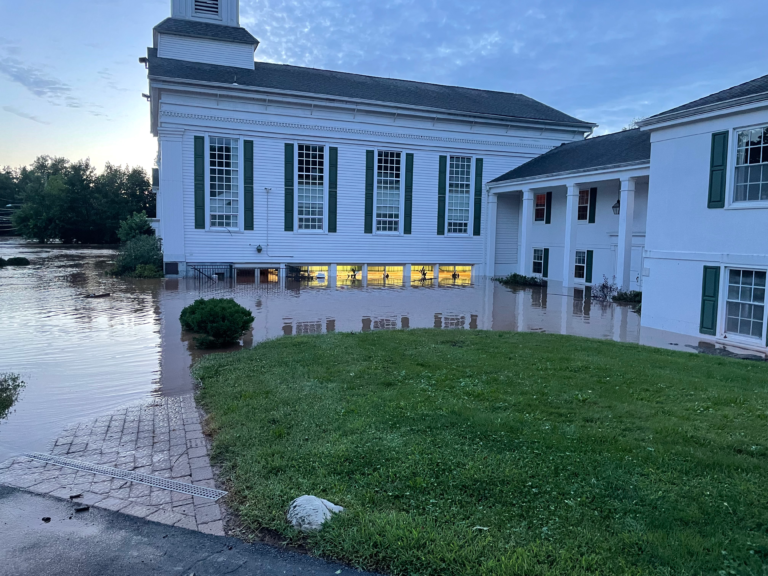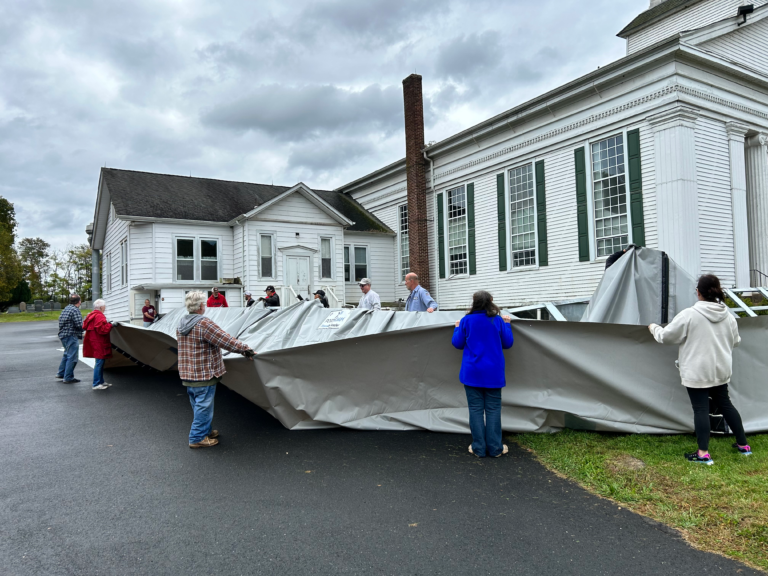
Download PDF version of the case study here.
Located in Hillsborough Township, NJ, across the street from a tributary of the Raritan River, the church opened its doors in 1850. The South Branch Reformed Church building is in the quintessential Greek Revival style, common in mid-nineteenth-century architecture, with tall, rounded Doric columns and massive doors and windows.
“It seems like every 10 years, we get walloped by a hurricane,” said Steve Eckert, Ordained Minister serving the church for the last 20 years. Beyond his pastoral duties, Eckert additionally holds a position as the Deputy Coordinator for the Hillsborough Townships’ Office of Emergency Management and is a Volunteer Firefighter and Fire Marshal.

The Church had been affected by three major hurricanes; Floyd in 1999, Irene in 2011, and Ida in 2021, destructively flooding the property. The building was initially flooded in 1999 by Hurricane Floyd, but the church congregation had maintained a positive outlook—after all, the church had never been flooded before. They simply hoped that it wouldn’t happen again until Hurricane Irene came to prove them wrong. In a matter of 60 minutes, the situation had changed from being under control, to standing in 4–5 feet of water in the kitchen area. As Irene flooded the building a second time, they could locate where and how the water was entering the building. To help manage and mitigate any future flooding, one of the initial steps included the installation of a ball valve at one of the main water outflow channels.
“I could deal with six inches to a foot of water in the dining room, just not 5 to 6 feet,” said Eckert.
As Ida brought rain over the Township, the hurricane flooded the South Branch of the Raritan River, neighboring the church. With the increased water levels reaching new areas, its namesake river consequently flooded the church, leaving them standing in water reaching 4–8 feet deep in some rooms. It was calculated that some 178,000 gallons of water had entered the building.

“It happened so quickly that we didn’t have time to shut the ball valve…. We were in here working, and then all of a sudden, the door broke, and we were off to the races. Water came in from the areas surrounding the church building.”

Not only did Hurricane Ida break their well tank, but the Church had to rebuild two boilers, tear up and reseal the concrete floor, and rebuild the whole kitchen, including two brand new commercial-style ovens, ten burners on top, and two ovens underneath.
“My insurance told me that because it’s the river, it’s an act of God.”
Insurance providers use the contractual language in their policies, typically covering flood events in the injuries, damages, and losses caused by “acts of God,” without any religious association, often defined as events beyond human control. Flood events are commonly, even in all-risk coverages, covered by this type of contractual language. Related damages are, therefore, often found not to be covered by insurance companies in the event of a disaster.
After initial conversations with the Portadam team, a site survey was completed. Together with Eckert and the Church’s Property Committee, the team analyzed the history of the site, its topography, and its relationship to the river. Building on decades of expertise, Portadam’s flood experts provided some ideas on how to customize a system that could proactively protect the church. A proposal was sent out, suggesting a “frontline defense,” as the risk mainly came from the river. The final solution, a four-foot FloodDefender system was designed and delivered to the church before the deployment training.
“The team really gave us the peace of mind that they’re developing a system for us: A system that is going to be very beneficial to our needs, and that could help us mitigate future flooding.”
Through both classroom and practical training, 28 people, including staff and parishioners, were educated on how to deploy the FloodDefender system. To ensure a technology that was both conforming to the highest safety standards
and easy to rapidly deploy, the patented solution was engineered with the end user in mind.

“The system is designed to be portable, easy to work with, but rugged and sturdy. You know, we think of a galvanized system, and automatically think it’s going to be too heavy, but I had 75-year-old people out there grabbing an A-frame and walking it to the front and putting it down, yet when it w as together, it was solid.”
Whether you have experienced past floodings or not, we help you identify your risks through multiple levels of assessments on and off the ground. Our services are tailored to meet custom needs. With nearly 50 years of experience, our team knows with firsthand experience that no one situation is the same. Our patented, storable, rapidly deployable FloodDefender has passed FM Approvals Functional Laboratory Testing and protects up to 100% of the system.